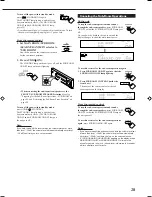
16
3. Connect the plug of the transmitter to the IR
OUT jack of the receiver and attach the
transmitter.
Horizontally: 60˚
Vertically: 60˚
15°
45°
30°
30°
Signal-emitting angle of the transmitter
Connecting the Power Cord
Before plugging the receiver into an AC outlet, make sure that all
connections have been made.
Plug the power cord into an AC outlet.
Keep the power cord away from the connecting cables and the
antenna. The power cord may cause noise or screen interference.
We recommend that you use a coaxial cable to connect the antenna,
since it is well-shielded against interference.
Note:
The preset settings such as preset channels and sound adjustment
may be erased in a few days in the following cases:
– When you unplug the power cord.
– When a power failure occurs.
CAUTIONS:
• Do not touch the power cord with wet hands.
• Do not pull on the power cord to unplug the cord.
When unplugging the cord, always grasp the plug so as not to
damage the cord.
Putting Batteries in the Remote Control
Before using the remote control, insert the two supplied batteries
first.
1. On the back of the remote control, remove the
battery cover.
2. Insert the batteries.
• Make sure to match the polarity: (+) to (+) and (–) to (–).
3. Replace the cover.
If the remote control cannot transmit signals or operate the receiver
correctly, replace the batteries. Use two LR6(AM3)/L40(15A) type
dry-cell batteries.
• When the remote control transmits a signal, the signal
transmission indicator on the remote’s display lights up.
Notes:
• If you aim the remote control directly at the remote sensor on the
receiver, you can operate the receiver at a distance of up to 7 m
(23 feet).
• When replacing the batteries, finish it without delay; otherwise, the
stored signals are all erased (see pages 67 and 71).
When using the remote control in
the dark
Press LIGHT.
The buttons on the remote control are backlit while you are using
the remote control.
If you do not press any button for about 5 seconds, the backlight
will turn off.
CAUTIONS:
Follow these precautions to avoid leaking or cracking cells:
• Place batteries in the remote control so they match the polarity: (+)
to (+) and (–) to (–).
• Use the correct type of batteries. Batteries that look similar may
differ in voltage.
• Always replace both batteries at the same time.
• Do not expose batteries to heat or flame.
LIGHT
1
2
LR6(AM3)
/L40(15A)
3
Target component(s)
IR OUT
ANTENNA
RF REMOTE
BAND1
BAND2
Les
s th
an
3 m
(1
0 f
eet)
At an angle of
approx. 60°
EN01-16_RX-DP10VBK[J]_f
01.6.19, 0:26 PM
16
















































